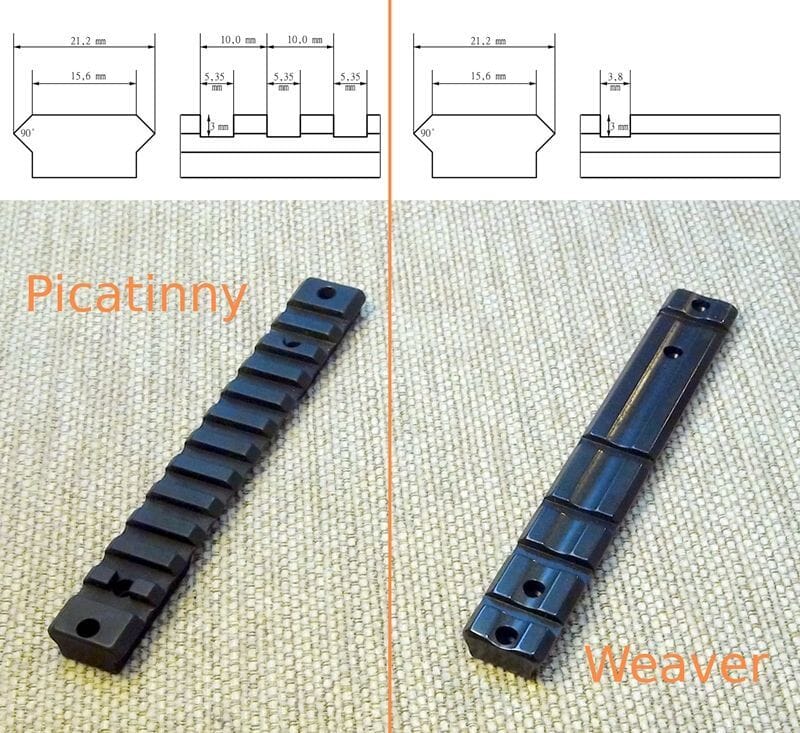Firearm Rails
Firearm rails refer to the mounting systems that are used to attach accessories, such as sights, scopes, and bipods, to firearms. Rails are typically located on the top, bottom, or side of the firearm, and provide a stable and secure platform for attaching accessories.
The most common types of rails used on firearms are the Picatinny rail, Weaver rail, and KeyMod and M-LOK.
Picatinny Rails
Picatinny rails are characterized by a series of ridges and slots that run along the length of the rail, and conform to a specific MIL-STD-1913 standard, which makes them versatile, durable and easy to find accessories that fits in.
Weaver Rails
Weaver rails have a series of parallel grooves cut into the rail, which allow for the attachment of accessories using a cross-slot design. They are one of the oldest types of rails and are less common than Picatinny rails but still a reliable option.
KeyMod & M-LOK Rails
KeyMod and M-LOK rails are modern alternative to Picatinny and weaver rails, both uses a modular attachment system, KeyMod uses a series of key-shaped slots that are used to attach accessories directly to the rail, while M-LOK uses a series of slots that are cut into the rail at a 45-degree angle, which allows for the attachment of accessories using a T-shaped nut.
These rails allow for a variety of accessories to be mounted on the firearm, such as scopes, sights, laser pointers, flashlights, and bipods, and enable the user to customize their firearm to fit their specific needs and preferences.
It's important to keep in mind that not all accessories are compatible with all types of rails, so it's a good idea to choose a rail that is compatible with the accessories you plan to use. Additionally, it's also important to make sure that the rail is compatible with the specific make and model of your firearm before making a purchase.
Accessories your rail with the reflex red dot sight from 2nd Amen:
Here is a shortlist of the most common rails systems, Excluding Picatinny:
-
Weaver Rails: Weaver rails are one of the oldest types of rails and were developed by William Ralph Weaver in the 1930s. They consist of a series of parallel grooves cut into the rail, which allow for the attachment of accessories using a cross-slot design.
-
STANAG Rails: STANAG stands for "STandardization AGreement," and refers to the NATO standard for rails that was adopted in the 1990s. STANAG rails are similar to Picatinny rails in that they have a series of ridges and slots, but they are slightly narrower and have a different spacing between the slots.
-
KeyMod Rails: KeyMod is a relatively new standard that was developed as an alternative to Picatinny and STANAG rails. KeyMod rails use a modular attachment system that consists of a series of key-shaped slots that are used to attach accessories directly to the rail. KeyMod systems are generally considered to be more lightweight and flexible than other types of rails.
-
M-LOK Rails: M-LOK is another modular attachment system that was developed as an alternative to Picatinny and KeyMod rails. M-LOK uses a series of slots that are cut into the rail at a 45-degree angle, which allows for the attachment of accessories using a T-shaped nut. Like KeyMod, M-LOK systems are generally considered to be more lightweight and flexible than other types of rails.
These are the most commonly used rails, but there are other types as well, like Dovetail, and some proprietary designs. It's important to keep in mind that not all accessories are compatible with all types of rails, so it's a good idea to choose a rail that is compatible with the accessories you plan to use.



2 comments
Tony Rippetoe
Can you install these rails to any gun
hrttacticalgear.com
This article provides an incredibly detailed and insightful breakdown of the various gun rails available, namely Picatinny, Weaver, KeyMod, and mlok . The author’s thorough exploration of each type ensures that readers, whether seasoned enthusiasts or beginners, can make informed decisions about the best fit for their weapons.
The side-by-side comparison of Picatinny and Weaver rails is particularly useful, highlighting their similarities and differences. This clarity is invaluable for those looking to understand the compatibility and interchangeability of accessories between the two systems. The historical context provided gives a richer understanding of the evolution of these standards.
The explanation of KeyMod and M-LOK adds another layer of depth to the article. Understanding the philosophy behind these modular systems and how they address the limitations of the earlier rail designs is crucial for individuals looking to upgrade their weapon setups. The visual aids used effectively complement the detailed explanations, making it easier for readers to grasp the nuances.
The practical considerations for each rail system, such as weight, flexibility, and ease of use, are well-addressed. This ensures that readers not only comprehend the technical aspects but also appreciate the real-world implications of choosing one rail system over another. The inclusion of examples and scenarios adds a practical dimension to the information, aiding readers in envisioning the application of each rail type.
Furthermore, the author’s unbiased approach in presenting the pros and cons of each rail system contributes to the article’s credibility. It allows readers to make decisions based on their specific needs and preferences, rather than promoting a one-size-fits-all solution.
In conclusion, “The Best Gun Rails for Your Weapon” stands out as a comprehensive and illuminating guide. Whether you’re a seasoned gun owner or a newcomer to the world of firearms, this article equips you with the knowledge needed to navigate the myriad choices in gun rails. Kudos to the author for demystifying the complexities and providing a valuable resource for anyone seeking to optimize their weapon configuration. Highly recommended!